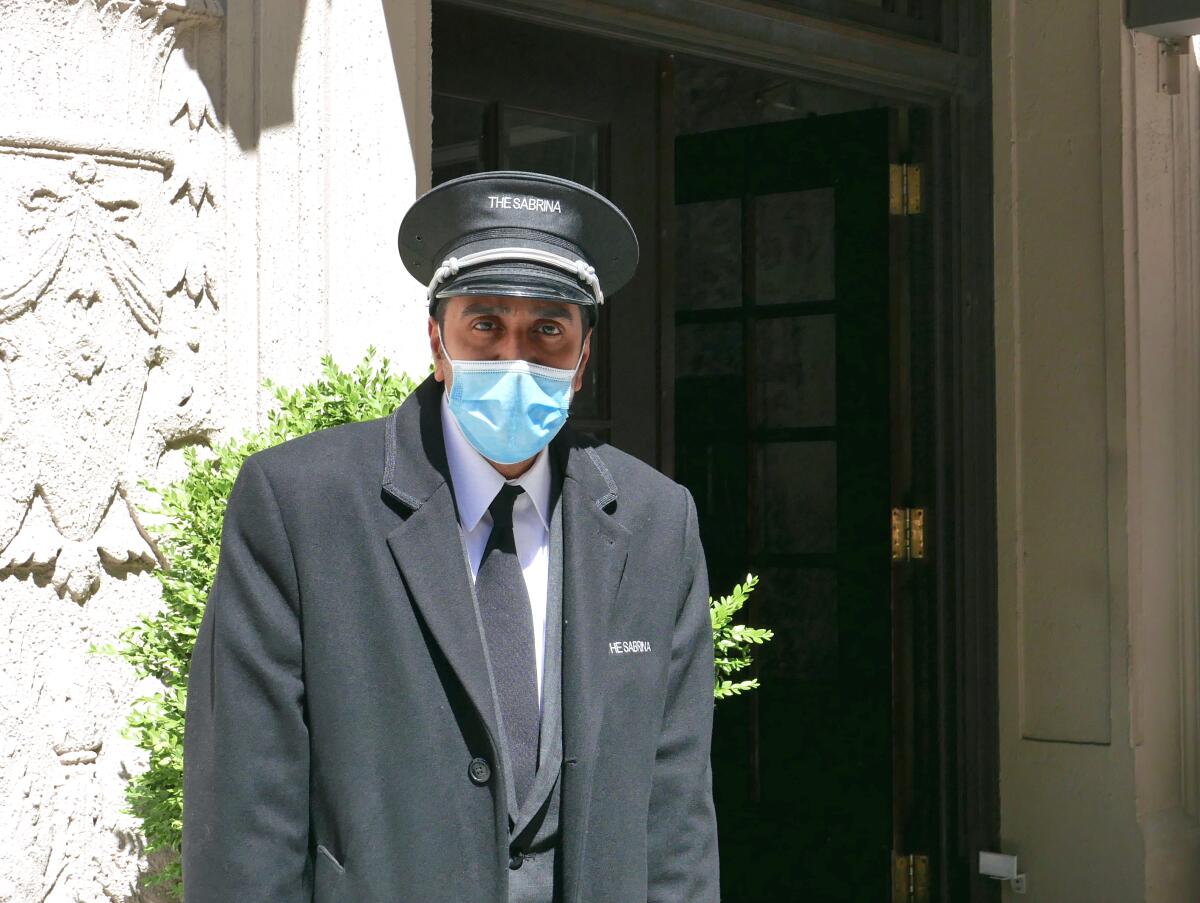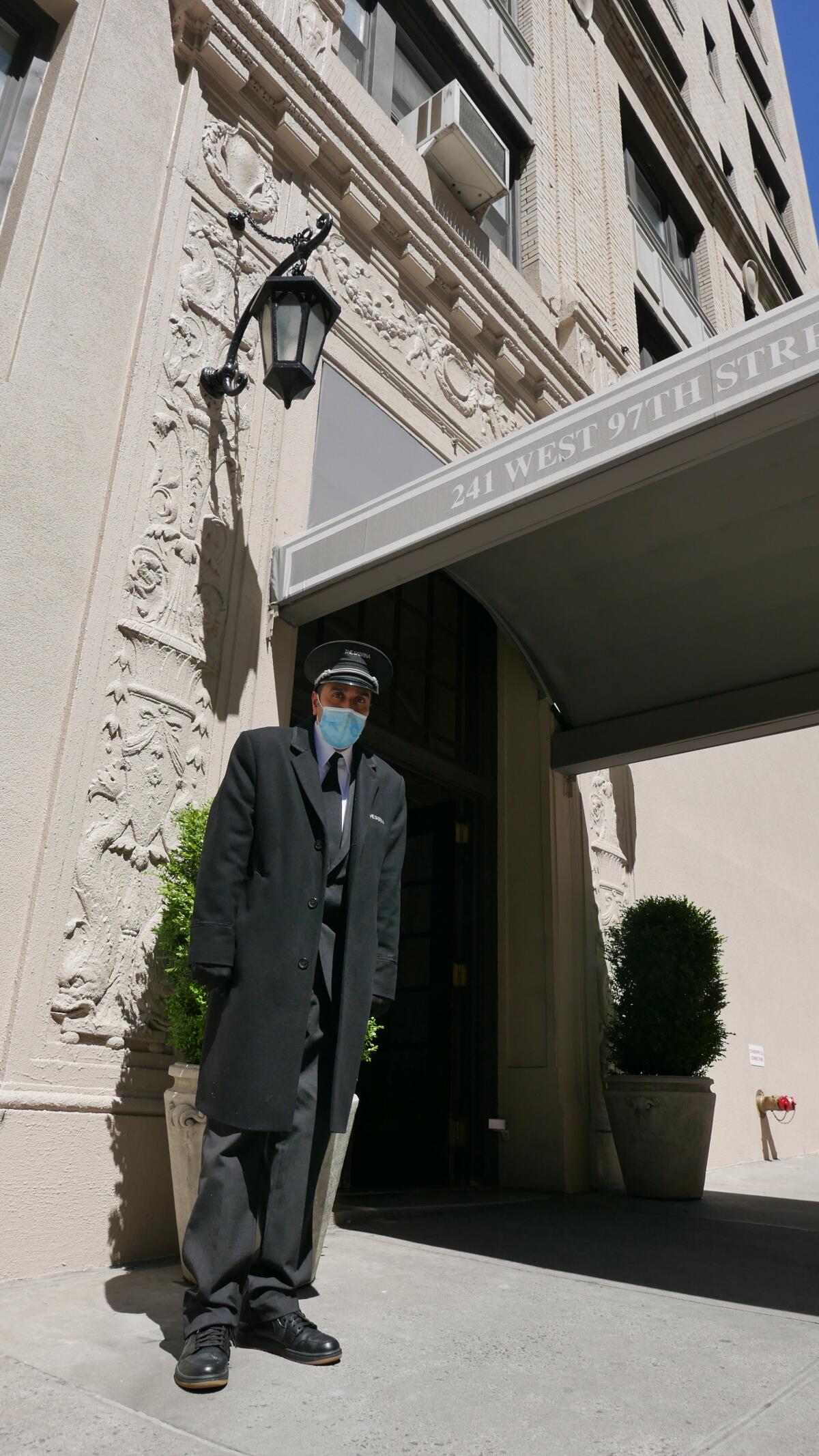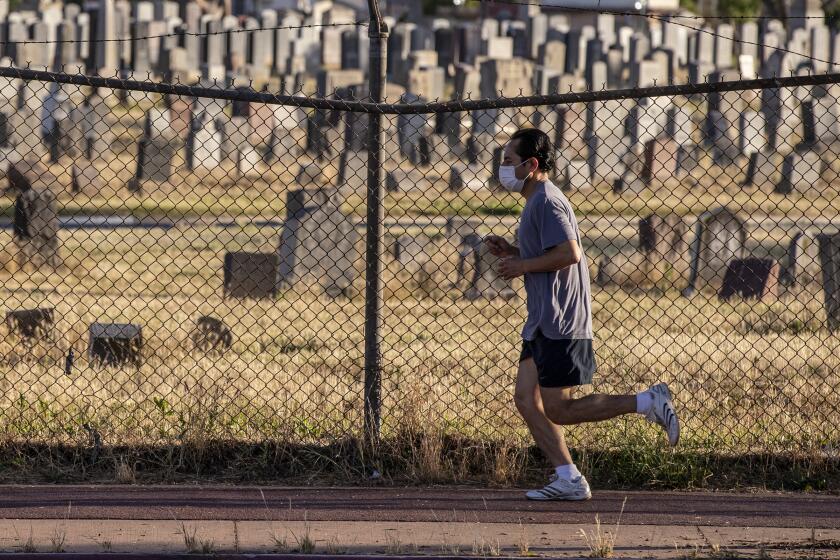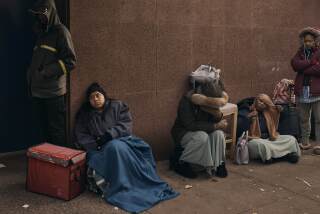While New York City fights a pandemic, building doormen greet and troubleshoot

For the last two months, New York City building doorman Louis DeJesus has seen the warm daily greetings he enjoyed exchanging with residents turn into muffled hellos and distant waves.
The daily check-ins on elderly residents became filled with trepidation. Packages delivered to lobbies were wiped down with disinfectant before being dropped off outside an apartment door. Elevator buttons and door handles were sanitized over and over.
It’s been a major shift for many residential doormen — the job’s contractual title even though it’s also filled by women — in response to the state’s shelter-in-place order set in March to try to contain the COVID-19 pandemic. Social distancing has disrupted the connection between DeJesus and residents at the 168-unit condominium on Manhattan’s Upper West Side where he has worked for 17 years.
“We play with their kids, we talk about things and life, we hug each other,” DeJesus said. “Everybody knows me as an outgoing guy. That’s why I’m good at what I do. It’s kind of awkward now. It’s hi and bye.”
Such is the state of existence for many of the 35,000 residential building employees — which also include handymen and porters — who were deemed essential workers by the state when the shelter-in-place order was implemented. The coronavirus has added a frightening layer of risk to what are considered among the most coveted working class positions in New York City, with a median annual salary of $52,000 and a contract that provides an employer-paid healthcare plan and a pension.
As of Thursday, more than 200 residential building staff members had contracted COVID-19 and 39 of them had died, according to Local 32BJ, the branch of the Service Employees International Union that represents the workers. It’s a higher death rate than the New York Police Department, which has lost 42 members to the virus out of a workforce of 55,000.
Turnover is low as most employees stay with their buildings for decades. The longevity in the jobs creates a bond with residents, who depend on the workforce to bring civility, safety and a sense of community to their lives.
“It is not by any stretch of the imagination a typical employer-employee relationship,” said Howard Rothschild, president of the Realty Advisory Board on Labor Relations, which negotiates the master contract with the doormen’s union as well as the city’s office building workers.
Building management companies and the board have tried to be mindful of the relationship workers have with their employers as they seek to adapt to the challenges brought on by the health crisis. The board adjusted the current contract, expanding the amount of paid time off for employees who are exposed to COVID-19 in the workplace, and publicly stating its intention to protect workers and preserve jobs during the economic shutdown.
Management agents and the union have moved to address the workforce’s biggest concern — commuting to their jobs. Many of the employees at Manhattan residences travel in from the outer boroughs of Queens, Brooklyn and the Bronx, which all have a much higher number of coronavirus cases.
“There was a lot of fear over coming home and infecting their family members,” said John Santos, vice president and New York Metro District residential director for Local 32BJ.
The union’s contract has been amended to allow workers to go from five eight-hour shifts per week to three 12-hour shifts, to reduce the number of commutes, while building owners absorb the cost of a shorter work week. Some but not all employers have also reimbursed their workers who choose to use ride-sharing services or parking for their own vehicles to avoid mass transit.
To help meet the demand for protective personal equipment, building owners banded together to make bulk purchases of face masks and gloves, said Dennis DePaola, executive vice president and general counsel for Orsid Realty Corp., which manages 175 residential properties that employ 2,000 people throughout the New York City region.
The county’s fatalities account for nearly 60% of the COVID-19 deaths in the state, which has recorded more than 3,500 deaths.
As building staffs received the proper protective gear, new protocols were put in place to ensure their safety. It has also meant pulling back on the level of service that residents depend on.
“Leaky faucets or changing light bulbs go unfixed,” DePaola said. “As long as it’s not going to overflow, we’re not touching it. If there is a significant risk of property damage then we’ll do so under social distancing guidelines.”
Ronnie Correa, a doorman at a Park Avenue cooperative apartment complex built in 1921, said the situation can be nerve-wracking.
“We try not to think about it,” Correa said. “Several tenants in our building can’t do very much. We have to take the risk and go in and help.”
Correa has seen his responsibilities intensify during the pandemic. Relatives of elderly occupants in his building have his cellphone number and some call daily to ask him for updates on their loved ones. During his lunch hour, he will do grocery shopping or run errands for some of the residents who can’t leave their apartments.
“I don’t mind it,” he said. “I like it. It’s brought us closer together.”
The additional pressure the workers face has been somewhat mitigated by the exodus of many residents in upscale buildings who headed for second homes in upstate New York or Long Island. Occupancy rates in luxury buildings along Fifth and Park Avenues are under 50%.
Correa, DeJesus and others said residents have observed the rules and shown no resentment over reduced services during the trying period. Some have received bonus checks from residents for their efforts.
“When this is done, I’m going to write a personal letter to everyone in the building,” DeJesus said. “They have been great.”
But in the back of the mind of workers and management agents is the possible impact of a prolonged economic downturn in New York City.
DePaola said building owners have to pay for personal protection equipment and additional salaries for relief staff that fill in for workers who get sick, refuse to come in, or have been exposed to someone who has the virus, requiring them to be quarantined for two weeks.

At the same time, income from rents and maintenance or condominium common charges could fall as unemployment rises and people are less able to pay. Residential buildings that have retail businesses as tenants, providing as much as 40% of their operating budgets, have seen that revenue disappear as well.
Rothschild becomes concerned when he hears politicians call for a freeze on rent, maintenance fees and mortgage payments as a means of providing economic relief during the pandemic.
“That could be a big problem,” he said. “The other service people in the building want to get paid. The bank wants to get paid the mortgage. The city wants its taxes. Anyone who can possibly pay should be paying.”
The coronavirus has killed about 15,400 people in the city and brought on economic uncertainty, especially for the real estate industry. Residents in buildings with doormen are hoping it doesn’t permanently interfere with the ritual they have long enjoyed.
“The doormen are really part of our lives,” said Betsy West, a filmmaker and professor at Columbia University who lives in a cooperative apartment building in Morningside Heights. “The pandemic has changed things a little bit. You feel a little uncomfortable standing in a closed-in lobby, even if you have masks on.”
More to Read
Sign up for Essential California
The most important California stories and recommendations in your inbox every morning.
You may occasionally receive promotional content from the Los Angeles Times.












